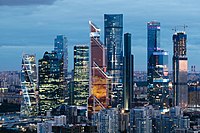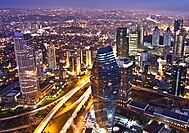Europe
Europe is a continent located entirely in the Northern Hemisphere and mostly in the Eastern Hemisphere. It is bordered by the Arctic Ocean to the north, the Atlantic Ocean to the west, the Mediterranean Sea to the south, and Asia to the east. Europe shares the landmass of Eurasia with Asia, and of Afro-Eurasia with both Asia and Africa. Europe is commonly considered to be separated from Asia by the watershed of the Ural Mountains, the Ural River, the Caspian Sea, the Greater Caucasus, the Black Sea, and the waterways of the Turkish straits.
Europe covers about 10.18 million km2 (3.93 million sq mi), or 2% of Earth's surface (6.8% of land area), making it the second-smallest continent (using the seven-continent model). Politically, Europe is divided into about fifty sovereign states, of which Russia is the largest and most populous, spanning 39% of the continent and comprising 15% of its population. Europe had a total population of about 745 million (about 10% of the world population) in 2021; the third-largest after Asia and Africa. The European climate is affected by warm Atlantic currents, such as the Gulf Stream, which produce a temperate climate, tempering winters and summers, on much of the continent. Further from the sea, seasonal differences are more noticeable producing more continental climates
European culture consists of a range of national and regional cultures, which form the central roots of the wider Western civilisation, and together commonly reference ancient Greece and ancient Rome, particularly through their Christian successors, as crucial and shared roots. Beginning with the fall of the Western Roman Empire in 476 CE, Christian consolidation of Europe in the wake of the Migration Period marked the European post-classical Middle Ages. After a renewal of access to and interest in historic and non-Christian knowledge and views the Renaissance, radiating from Florence, spread to the rest of the continent a new humanist interest in art and science. Since the Age of Discovery, led by Spain and Portugal, Europe played a predominant role in global affairs with multiple explorations and conquests around the world. Between the 16th and 20th centuries, European powers colonised at various times the Americas, almost all of Africa and Oceania, and the majority of Asia.
The Age of Enlightenment, the French Revolution, and the Napoleonic Wars shaped the continent culturally, politically and economically from the end of the 17th century until the first half of the 19th century. The Industrial Revolution, which began in Great Britain at the end of the 18th century, gave rise to radical economic, cultural and social change in Western Europe and eventually the wider world. Both world wars began and were fought to a great extent in Europe, contributing to a decline in Western European dominance in world affairs by the mid-20th century as the Soviet Union and the United States took prominence and competed over dominance in Europe and globally. The resulting Cold War divided Europe along the Iron Curtain, with NATO in the West and the Warsaw Pact in the East. This divide ended with the Revolutions of 1989, the fall of the Berlin Wall, and the dissolution of the Soviet Union, which allowed European integration to advance significantly.
European integration is being advanced institutionally since 1948 with the founding of the Council of Europe, and significantly through the realization of the European Union (EU), which represents today the majority of Europe. The European Union is a supranational political entity that lies between a confederation and a federation and is based on a system of European treaties. The EU originated in Western Europe but has been expanding eastward since the dissolution of the Soviet Union in 1991. A majority of its members have adopted a common currency, the euro, and participate in the European single market and a customs union. A large bloc of countries, the Schengen Area, have also abolished internal border and immigration controls. Regular popular elections take place every five years within the EU; they are considered to be the second-largest democratic elections in the world after India's. The EU is the third largest economy in the world.
Name
The place name Evros was first used by the ancient Greeks to refer to their northernmost province, which bears the same name today. The principal river there – Evros (today's Maritsa) – flows through the fertile valleys of Thrace.
In classical Greek mythology, Europa (Ancient Greek: Εὐρώπη, Eurṓpē) was a Phoenician princess. One view is that her name derives from the Ancient Greek elements εὐρύς (eurús) 'wide, broad', and ὤψ (ōps, gen. ὠπός, ōpós) 'eye, face, countenance', hence their composite Eurṓpē would mean 'wide-gazing' or 'broad of aspect'. Broad has been an epithet of Earth herself in the reconstructed Proto-Indo-European religion and the poetry devoted to it. An alternative view is that of Robert Beekes, who has argued in favour of a Pre-Indo-European origin for the name, explaining that a derivation from eurus would yield a different toponym than Europa. Beekes has located toponyms related to that of Europa in the territory of ancient Greece, and localities such as that of Europos in ancient Macedonia.
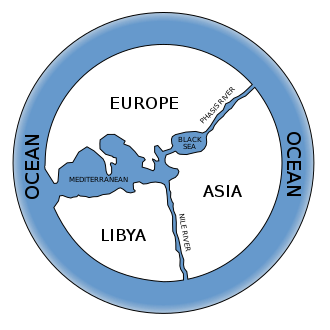
There have been attempts to connect Eurṓpē to a Semitic term for west, this being either Akkadian erebu meaning 'to go down, set' (said of the sun) or Phoenician 'ereb 'evening, west', which is at the origin of Arabic maghreb and Hebrew ma'arav. Martin Litchfield West stated that "phonologically, the match between Europa's name and any form of the Semitic word is very poor", while Beekes considers a connection to Semitic languages improbable.
Most major world languages use words derived from Eurṓpē or Europa to refer to the continent. Chinese, for example, uses the word Ōuzhōu (歐洲/欧洲), which is an abbreviation of the transliterated name Ōuluóbā zhōu (歐羅巴洲) (zhōu means "continent"); a similar Chinese-derived term Ōshū (欧州) is also sometimes used in Japanese such as in the Japanese name of the European Union, Ōshū Rengō (欧州連合), despite the katakana Yōroppa (ヨーロッパ) being more commonly used. In some Turkic languages, the originally Persian name Frangistan ('land of the Franks') is used casually in referring to much of Europe, besides official names such as Avrupa or Evropa.
Definition

The prevalent definition of Europe as a geographical term has been in use since the mid-19th century. Europe is taken to be bounded by large bodies of water to the north, west and south; Europe's limits to the east and north-east are usually taken to be the Ural Mountains, the Ural River, and the Caspian Sea; to the south-east, the Caucasus Mountains, the Black Sea, and the waterways connecting the Black Sea to the Mediterranean Sea.
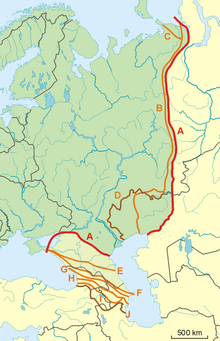
between Asia and Europe in different
periods of history. The commonly
accepted modern definition mostly fits
with the lines "B" and "F" in this image.

by Günther Zainer in 1472, showing
the three continents as domains of
the sons of Noah – Asia to Sem
(Shem), Europe to Iafeth (Japheth)
and Africa to Cham (Ham)
Islands are generally grouped with the nearest continental landmass, hence Iceland is considered to be part of Europe, while the nearby island of Greenland is usually assigned to North America, although politically belonging to Denmark. Nevertheless, there are some exceptions based on sociopolitical and cultural differences. Cyprus is closest to Anatolia (or Asia Minor), but is considered part of Europe politically and it is a member state of the EU. Malta was considered an island of North-western Africa for centuries, but now it is considered to be part of Europe as well. "Europe", as used specifically in British English, may also refer to Continental Europe exclusively.
The term "continent" usually implies the physical geography of a large land mass completely or almost completely surrounded by water at its borders. Prior to the adoption of the current convention that includes mountain divides, the border between Europe and Asia had been redefined several times since its first conception in classical antiquity, but always as a series of rivers, seas and straits that were believed to extend an unknown distance east and north from the Mediterranean Sea without the inclusion of any mountain ranges. Cartographer Herman Moll suggested in 1715 Europe was bounded by a series of partly-joined waterways directed towards the Turkish straits, and the Irtysh River draining into the upper part of the Ob River and the Arctic Ocean. In contrast, the present eastern boundary of Europe partially adheres to the Ural and Caucasus Mountains, which is somewhat arbitrary and inconsistent compared to any clear-cut definition of the term "continent".
The current division of Eurasia into two continents now reflects East-West cultural, linguistic and ethnic differences which vary on a spectrum rather than with a sharp dividing line. The geographic border between Europe and Asia does not follow any state boundaries and now only follows a few bodies of water. Turkey is generally considered a transcontinental country divided entirely by water, while Russia and Kazakhstan are only partly divided by waterways. France, the Netherlands, Portugal and Spain are also transcontinental (or more properly, intercontinental, when oceans or large seas are involved) in that their main land areas are in Europe while pockets of their territories are located on other continents separated from Europe by large bodies of water. Spain, for example, has territories south of the Mediterranean Sea—namely, Ceuta and Melilla—which are parts of Africa and share a border with Morocco. According to the current convention, Georgia and Azerbaijan are transcontinental countries where waterways have been completely replaced by mountains as the divide between continents.
Geography
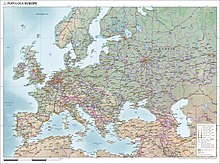
surrounding regions showing
physical, political and population
characteristics, as per 2018
Europe makes up the western fifth of theEurasianlandmass.It has a higher ratio of coast to landmass than any other continent or subcontinent.Its maritime borders consist of the Arctic Ocean to the north, the Atlantic Ocean to the west and the Mediterranean, Black and Caspian Seas to the south.Land relief in Europe shows great variation within relatively small areas. The southern regions are more mountainous, while moving north the terrain descends from the highAlps,PyreneesandCarpathians, through hilly uplands, into broad, low northern plains, which are vast in the east. This extended lowland is known as theGreat European Plainand at its heart lies theNorth German Plain. An arc of uplands also exists along the north-western seaboard, which begins in the western parts of the islands of Britain and Ireland, and then continues along the mountainous, fjord-cut spine of Norway.
This description is simplified. Subregions such as the Iberian Peninsula and the Italian Peninsula contain their own complex features, as does mainland Central Europe itself, where the relief contains many plateaus, river valleys and basins that complicate the general trend. Sub-regions like Iceland, Britain and Ireland are special cases. The former is a land unto itself in the northern ocean that is counted as part of Europe, while the latter are upland areas that were once joined to the mainland until rising sea levels cut them off.
Major cities and urban areas
The three largest urban areas of Europe are Moscow, London and Paris. All have over 10 million residents, and as such have been described as megacities. While Istanbul has the highest total city population, it lies partly in Asia. 64.9% of the residents live on the European side and 35.1% on the Asian side. The next largest cities in order of population are Madrid, Saint Petersburg, Milan, Barcelona, Berlin, and Rome each having over three million residents.
When considering the commuter belts or metropolitan areas within Europe (for which comparable data is available), Moscow covers the largest population, followed in order by Istanbul, London, Paris, Madrid, Milan, Ruhr Area, Saint Petersburg, Rhein-Süd, Barcelona and Berlin.
Culture

continent split along cultural and state borders
as proposed by the German organisation
Ständiger Ausschuss für geographische Namen (StAGN)
"Europe" as a cultural concept is substantially derived from the shared heritage of ancient Greece and the Roman Empire and its cultures. The boundaries of Europe were historically understood as those of Christendom (or more specifically Latin Christendom), as established or defended throughout the medieval and early modern history of Europe, especially against Islam, as in the Reconquista and the Ottoman wars in Europe.
This shared cultural heritage is combined by overlapping indigenous national cultures and folklores, roughly divided into Slavic, Latin (Romance) and Germanic, but with several components not part of either of these groups (notably Greek, Basque and Celtic). Historically, special examples with overlapping cultures are Strasbourg with Latin (Romance) and Germanic, or Trieste with Latin, Slavic and Germanic roots. Cultural contacts and mixtures shape a large part of the regional cultures of Europe. Europe is often described as "maximum cultural diversity with minimal geographical distances".
Different cultural events are organised in Europe, with the aim of bringing different cultures closer together and raising awareness of their importance, such as the European Capital of Culture, the European Region of Gastronomy, the European Youth Capital and the European Capital of Sport.
Sport

Europe. Camp Nou stadium in Barcelona,
the largest in Europe.
Sport in Europe tends to be highly organized with many sports having professional leagues.
The origins of many of the world's most popular sports today lie in the codification of many traditional games, especially in the United Kingdom. However, a paradoxical feature of European sport is the extent to which local, regional and national variations continue to exist, and even in some instances to predominate.[318]Social dimension
In Europe many people are unable to access basic social conditions, which makes it harder for them to thrive and flourish. Access to basic necessities can be compromised, for example 10% of Europeans spend at least 40% of household income on housing. 75 million Europeans feel socially isolated. From the 1980s income inequality has been rising and wage shares have been falling. In 2016, the richest 20% of households earned over five times more than the poorest 20%. Many workers experience stagnant real wages and precarious work is common even for essential workers.


